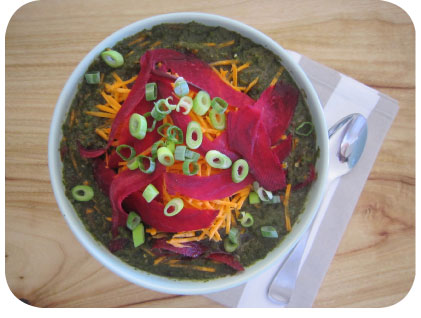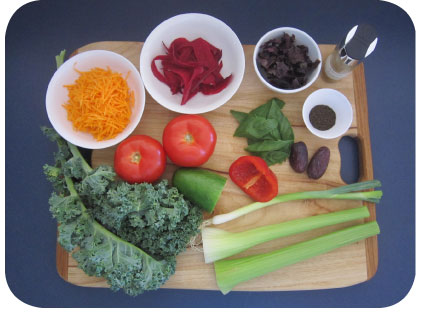be inspired collection
Big Benefits of Blended Salad
written by Dr Joel Fuhrman MD
Big Benefits of Blended Salad
A powerful and delicious way to maximize your intake of nutrients

What is a blended salad, and why would I want to eat one?
A blended salad is a mixture of raw, leafy greens and other foods blended together to make a smooth, creamy salad with a baby-food-like consistency. Eating a salad prepared in this manner is quick and convenient, and increases absorption of important nutrients. By adding fruits, nuts, and other ingredients, you can support health and healing with a truly gourmet eating experience.
By singing the praises of blended salads, I don’t want to give the impression that a regular “chewed salad” is not a highly-recommended source of nutrients. Blended salads are simply a great addition to the already superior, anti-cancer style of eating that I recommend.
What are the advantages of eating a blended salad as opposed to eating a regular salad?
All plants are composed of cells whose walls consist mainly of cellulose, which is a type of carbohydrate. A plant-based diet (one rich in fruits and vegetables) contains a large amount of cellulose. Humans do not have the enzyme capable of breaking down cellulose, so we cannot utilize cellulose as an energy source. If we eat cellulose-rich, raw greens without thoroughly masticating them, we lose much of the food value.
To get as many nutrients as possible into your bloodstream, the plant walls must be broken open to release the nutrients inside the cell. When we simply chew a salad, about seventy to ninety percent of the cells are not broken open. As a result, most of the valuable nutrients contained within those cells never enter our bloodstream. Blending raw, leafy greens guarantees that a higher percentage of nutrients will be absorbed into your bloodstream for your body to use.
Why is it important to consume cellulose and other plant fibers?
Many types of bacteria found in the colon and large intestine are capable of digesting small amounts of fiber, such as cellulose. Some of the positive results of this bacterial activity on fibrous, non-absorbable food residue are the production of vitamin K, vitamin B-12, thiamine, and riboflavin.
Human feces normally should be composed of about fifty percent water and fifty percent solid materials. Cellulose holds water in your gut, which allows easier passage of stool. This helps to prevent constipation, hemorrhoids, and the formation of colonic diverticula. Consuming sufficient quantities of raw vegetables assures that you will have normal bowel health throughout life. These same factors also are important in the prevention of colon cancer.

What is it about the digestion process of raw foods that promotes weight loss?
The solid portion of human feces is normally composed of about thirty percent dead bacteria and seventy percent undigested roughage and sloughed off epithelial cells. When food is chewed, it is mixed with saliva, which contains the enzyme ptyalin. This enzyme hydrolyzes starch into simpler sugars. However, since the food remains in the mouth for only a short period of time, only three-to-five percent of all the starches eaten will become hydrolyzed by the time the food is swallowed.
Although green vegetables contain small amounts of starch, these naturally occurring starches are digested very poorly by ptyalin. This is because the starch is contained in small globules encased within a thin, protective, cellulose membrane. Unless these protective cell membranes are broken down by cooking (or blending, see next paragraph), little of the starch content is available for digestion and assimilation. For example, even though carrots, sweet potatoes, and beets are high in starch, if you consume them raw in a salad, only a small percent of the calories are absorbed due to the cellulose packaging of the starch. This is one of the reasons why raw vegetables are such effective weight-loss-promoting foods. People in need of weight reduction can consume virtually unlimited quantities of raw vegetables, but not cooked starches.
Green vegetables, especially leafy greens, are protein-rich and not high in carbohydrates. They are comparatively low in calories and have a very high nutrient-to-calorie ratio. When leafy greens are blended, most of the cellulose packages are opened, and the beneficial nutrients can be absorbed successfully. Certainly, more and better chewing is advised, but most people don’t chew their salads well enough. Even if they did, they could not expect to crush the cell walls with the same efficiency as the blades of a blender spinning at hundreds of revolutions per second.
How effectively do we absorb the protein in green vegetables?
Even ingested meats are poorly penetrated by digestive enzymes when they are inadequately chewed and swallowed in small chunks. By contrast, when you consume a blended salad, you are assuring a thorough digestion of the plant protein. Ninety-eight percent of all the proteins will be broken down into amino acids or very small peptides, and absorption will be almost complete as well. As a result, you absorb almost all the protein in the raw greens, instead of losing so much. No one chews well enough to break down food this well.
Approximately fifty percent of your digested and absorbed protein (amino acids) comes from ingested food, about twenty-five percent from protein in digestive juices that are reabsorbed, and twenty-five percent from desquamated mucosal cells (cells that have sloughed off the lining of the digestive tract). If adequately chewed or broken down, only about two-to-five percent of protein consumed escapes digestion and absorption.
Besides increasing the protein and micronutrient absorption and availability, blending a salad generally increases the amount of raw greens a person consumes. Many people have trouble eating six-to-sixteen ounces (175 – 450 g) of leafy greens daily, the amount usually recommended in my diets. Eating this quantity of raw blended greens is quite easy. Most people who try them find blended salads to be delicious and really look forward to this portion of the diet.
When would you most likely recommend a blended salad?
Some people have difficulty digesting large quantities of roughage when they first switch to a high-phytochemical, natural, plant-based diet. These individuals can solve their problems with gas and bloating by blending their salads before eating them. For example, patients with Crohn’s disease or colitis often do not tolerate raw salad well, but blended salads can offer these individuals the benefits of this high-nutrient food source, without the negative effects of the roughage. Those who have difficulty chewing also can benefit from blended salads.
The high-nutrient availability of blended salads aids those recovering from illness, and helps normalize immune function in those suffering from asthma, allergies, and other immune system disorders. Those with added nutritional requirements – such as nursing mothers and athletes – find that blended salads can be used to increase milk supply and athletic performance.
Those interested in maximising weight loss in a healthful manner can use blended salads to increase their consumption of greens before meals. This will supply them with a dynamite nutrition punch while at the same time providing satiety to prevent over-eating on the higher-calorie foods that follow.
High-performance athletes or those interested in gaining weight can mix nuts and seeds into their blended salads. This combination supplies healthful sources of protein and fat in an efficiently-absorbed, high-nutrient package.
To learn more about Dr Joel Fuhrman click here
For ideas on how to make blended salads click here



